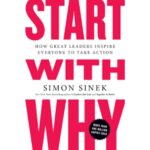LISTEN NOW
Outline: Start With Why: How Great Leaders Inspire Everyone to Take Action by Simon Sinek
Outline
Expand to Read ...
I. Introduction
- Core Argument: Successful businesses and leaders operate from a clear sense of purpose—their WHY—which informs all aspects of their operations.
- Three Dimensions of WHY:
- Defining your WHY.
- Recognizing how your WHY influences your organization.
- Maintaining focus on your WHY over time.
II. Defining Your WHY
- Definition: Your WHY is your core belief and reason for existence, driving your daily actions and long-term mission.
- The Framework:
- WHY: The vision or mission—why you do what you do.
- HOW: The methods or principles that bring your WHY to life.
- WHAT: The tangible products or services you provide.
The Golden Circle
- Visualized as concentric rings:
- Inner Circle: WHY (core belief).
- Middle Circle: HOW (processes).
- Outer Circle: WHAT (products/services).
- Key Insight: Lead with WHY to inspire loyalty and trust, crafting messages that resonate deeply.
Examples:
- Apple:
- WHY: Challenge the norm and think differently.
- HOW: Create user-friendly, elegant designs.
- WHAT: Computers and other technology.
Pitfall of Starting With WHAT:
- Starting with WHAT focuses on features and surface-level benefits, failing to inspire long-term loyalty.
- Example: A brash sales pitch about material success is less engaging than sharing a heartfelt mission.
III. Inspiration vs. Manipulation
- Manipulative Tactics: Pricing, promotions, fear, and novelty can drive short-term sales but fail to build loyalty.
- Inspiration:
- Focuses on WHY.
- Draws in customers who share the company’s values.
- Builds trust and repeatable cycles of success.
Case Study: Brands like Apple, Southwest Airlines, and Harley-Davidson succeed by consistently leading with their WHY.
IV. Inspiring Your Team
- Role of Leaders: Exceptional leaders align their teams around a shared WHY, fostering trust and collaboration.
Benefits of an Inspired Team:
- Innovation:
- Employees find creative ways to bring the mission to life.
- Example: Steve Jobs inspired Apple’s team to create groundbreaking products.
- Resilience:
- A clear purpose helps employees see setbacks as learning opportunities.
- Trust:
- Shared goals foster mutual respect and interdependence across roles.
- Confidence in Leadership:
- Employees trust leaders who prioritize the organization’s mission over personal gain.
Building a Purpose-Driven Team:
- Recruit individuals who resonate with the mission, not just those with technical skills.
- Look beyond résumés to find candidates passionate about the organization’s purpose.
V. The Importance of WHY in Decision-Making
- The Celery Test: A framework for making aligned decisions.
- Example: If health is your WHY, prioritize buying celery over Oreos, ensuring alignment with your mission.
- Key Benefits:
- Speeds up decision-making.
- Aligns actions with organizational purpose.
- Builds trust with customers through consistency.
VI. Maintaining Focus on Your WHY
- Challenge: Success can lead organizations to lose sight of their WHY as they focus on operations and metrics.
- The Divide: This occurs when companies prioritize financial performance over their original purpose.
- Example: Microsoft, AOL, and Walmart experienced stagnation after shifting focus away from their WHY.
Strategies to Avoid the Divide:
- Embed Purpose at Every Level:
- Leaders articulate the WHY and empower teams to reflect it in their actions.
- Prioritize Purpose-Driven Metrics:
- Measure success by alignment with core beliefs, not just financial outcomes.
- Plan Leadership Transitions Thoughtfully:
- Ensure new leaders share the same commitment to the mission.
VII. Examples of Leaders Who Embodied Their WHY
1. The Wright Brothers vs. Samuel Pierpont Langley:
- Langley: Driven by fame and financial gain, abandoned his efforts after failure.
- Wright Brothers: Motivated by solving the challenge of flight, persevered despite limited resources, achieving success through purpose-driven innovation.
2. Apple, Inc.:
- Steve Jobs and Steve Wozniak shared a vision of empowering individuals through accessible technology.
- Apple thrived because of its focus on revolutionizing the status quo, not just selling computers.
3. Martin Luther King, Jr.:
- King unified people through his vision of a just and equal society, inspiring collective action for civil rights.
- Example: His “I Have a Dream” speech attracted 250,000 people without formal invitations, driven by shared belief in his WHY.
VIII. The Objective: Inspiration, Motivation, Action
- Impact of Effective Leadership:
- Builds loyalty through shared purpose.
- Inspires intrinsic motivation over external rewards.
- Elevates productivity, happiness, and resilience across organizations.
Potential Benefits of a WHY-Centric Approach:
- Increased employee satisfaction and engagement.
- Higher productivity fueled by passion and creativity.
- Enhanced trust and loyalty among customers.
IX. Conclusion
- Takeaway: Starting with WHY creates purpose-driven leaders, loyal followers, and enduring success.
- Final Insight: Great leaders inspire action by fostering a sense of belonging and articulating a shared vision for the future.

 Buy on Amazon
Buy on Amazon